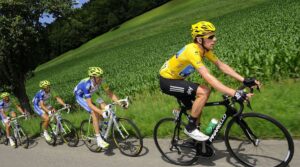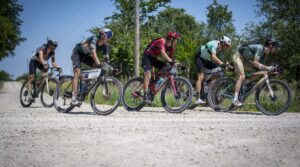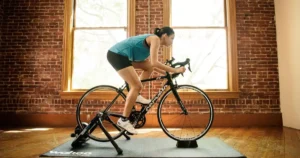Cycling engages and strengthens muscles, making them work together to pedal the bicycle. It targets the legs, especially the thighs and calves, promoting physical fitness. As you ride, muscles build endurance and tone, creating a healthy and strong body. So, cycling is a fun way to exercise and keep your muscles active.
Cycling is like a magical exercise that works wonders on your body. Imagine it as a friendly wizard, making your leg muscles strong and powerful. Pedaling a bike engages your thighs and calves, turning them into superheroes. So, the big question is, which muscles does cycling work? Let’s uncover the mystery together and embark on a journey to discover the muscle magic of cycling.
Cycling is like a gym on wheels. When you pedal, your leg muscles, like the thighs and calves, do all the heavy lifting. It’s a fantastic workout that turns ordinary muscles into superheroes. So, next time you ride, know that you’re giving those muscles a fun and healthy workout.
Understanding Cycling Work
Cycling is a dynamic full body workout that engages various muscle groups. The primary focus is on the lower body, specifically the thighs and calves. As you pedal, these muscles work together harmoniously, providing strength and endurance. Beyond the legs, cycling also activates the core muscles, helping to maintain stability and balance throughout the ride.
Cycling isn’t just a leg centric exercise, it involves a holistic approach to fitness. While the thighs and calves take center stage, the muscles in your back, arms, and even shoulders play supporting roles. This comprehensive engagement makes cycling an effective and efficient way to promote overall muscular health.
A Deep Dive into the Muscles Activated by Cycling
To truly appreciate the impact of cycling on muscles, let’s take a closer look at the key players. The quadriceps, located in the front of your thighs, bear the brunt of the pedaling force. Meanwhile, the hamstrings at the back of the thighs ensure a balanced effort. As you push down on the pedals, the gastrocnemius and soleus muscles in the calves come into action, creating a seamless, rhythmic motion.
In addition to these major muscle groups, cycling also engages the glutes, responsible for powering each pedal stroke. The continuous contraction and extension of these muscles during cycling contribute not only to strength but also to improved flexibility, a hidden benefit of this enjoyable exercise.
Discovering the Impact of Cycling on Thighs and Calves
A visual representation of the muscular engagement during cycling reveals an impressive symphony of movement. Picture a cyclist navigating a scenic route, with each pedal rotation, the quadriceps contract, propelling the bike forward. Simultaneously, the hamstrings and calf muscles work in harmony, ensuring a smooth and controlled cycling motion.
Let’s delve into the specifics by examining the following table summarizing the key data related to the impact of cycling on thighs and calves, including whether cycling increase testosterone levels, among other crucial aspects.
| Muscle Group | Role During Cycling |
| Quadriceps | Primary force for pedal downstroke |
| Hamstrings | Balancing the effort with pedal upstroke |
| Calves | Providing additional propulsion during pedal rotation |
| Gastrocnemius | Assisting the calves in generating pedal power |
This visual breakdown underscores the intricacies of muscle involvement, highlighting how cycling transforms simple movements into a complex and effective workout.
How Cycling Tones and Strengthens Key Muscle Groups
Beyond the physical exertion, cycling contributes significantly to muscle toning and strengthening. The consistent, repetitive nature of pedaling builds endurance in the targeted muscle groups. The quadriceps and hamstrings, being the workhorses of cycling, undergo a toning process that not only enhances their appearance but also fortifies them for increased performance.
As for the calves, the continuous contraction and extension develop lean muscle, contributing to a well defined lower leg. This toning effect extends to the core muscles, as they are constantly engaged to maintain balance. In essence, cycling not only promotes cardiovascular health but also sculpts and strengthens the body.
Exploring the Fitness Benefits of Regular Cycling

Cycling isn’t just about commuting or leisure, it’s a powerhouse of fitness benefits. Regular cycling improves cardiovascular health, boosting heart and lung efficiency. The sustained effort required in cycling helps burn calories, contributing to weight management.
Additionally, it reduces stress and enhances mental well being. The versatility of cycling, whether on roads or trails, makes it an enjoyable and effective way to stay fit.
A Guide to the Muscular Effects of Cycling
As a guide to the muscular effects of cycling, it’s essential to delve into the nuances of muscle engagement. The quadriceps, responsible for knee extension, power the downward stroke, while the hamstrings act as stabilizers.
The gastrocnemius and soleus in the calves play a crucial role in ankle extension. Understanding these dynamics provides insight into the targeted muscle effects, guiding individuals towards maximizing the benefits of their cycling workouts.
Ranking the Muscles Worked During a Cycling Adventure
Ranking the muscles worked during a cycling adventure emphasizes the collaborative effort of various muscle groups. The quadriceps take the lead, generating the primary force for pedal propulsion.
Following closely, the hamstrings and calf muscles contribute to pedal efficiency and stability. As cyclists navigate diverse terrains, the engagement of these muscles varies, providing a comprehensive workout for the entire lower body.
Maximizing Your Workout by Targeting Specific Muscles in Cycling
Unlock the secret to a supercharged cycling workout by honing in on specific muscles. Imagine your legs as superheroes, the quadriceps driving the pedals, the hamstrings providing stability, and the calves ensuring a smooth ride. It’s like a muscle adventure every time you hop on your bike.
So, let’s answer the exciting question, which muscles does cycling work? By focusing on these muscle heroes, you not only make your ride more effective but also turn cycling into a fun and rewarding fitness journey, especially when incorporating outdoor cycling workouts to engage these muscle groups further.
FAQ’s
What parts of my legs does cycling target?
Cycling primarily engages your thighs and calves. As you pedal, these muscles work together, getting stronger and more toned.
Does cycling help with overall body fitness?
Absolutely! Cycling isn’t just for legs. It also involves your core and even helps with cardiovascular health.
Can cycling replace a gym leg workout?
It’s a great complement. While cycling works your legs, some gym exercises can provide additional strength training.
Will cycling make my muscles bulky?
No worries! Cycling usually tones muscles without significant bulk, giving you a lean and fit look.
How often should I cycle for noticeable results?
Aim for regular sessions, at least a few times a week, to see improvements in muscle strength and overall fitness.
Conclusion
In the exciting world of cycling, our muscles become heroes! Pedaling works the thighs, calves, and more, making us strong and fit. Which muscles does cycling work?, you might ask. Well, it’s a team effort. Your legs, especially the thighs and calves, do most of the work, turning cycling into a fantastic workout adventure.
Remember, cycling isn’t just about moving your legs. It’s a full body friend, helping your heart, lungs, and even your balance. You don’t need a fancy gym for this, just your trusty bike. As we explored the magic of cycling through different muscles, from the mighty quads to the balancing hamstrings, we uncovered a secret: it’s not just exercise, it’s fun.
So, every time you hop on your bike, know that you’re not just riding, you’re letting your muscles shine. In conclusion, cycling is like a friendly wizard that makes our muscles strong and healthy. So, grab your bike, pedal away, and let the muscle magic begin.








